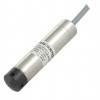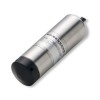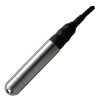Diesel fuel oil storage tank device for measuring liquid level and converting it to an electrical signal to send to other instrumentation protected from diesel ingress when completely immersed in the fuel oil.
Products
 18.605 G Low Cost Submersible Diesel Fuel and Water Tank Level Sensor - Low cost OEM diesel fuel or water level sensor for installing inside or outside a storage tank.
18.605 G Low Cost Submersible Diesel Fuel and Water Tank Level Sensor - Low cost OEM diesel fuel or water level sensor for installing inside or outside a storage tank.
Applications
 2 metre deep diesel tank level sensor for submersion - Submersible diesel level pressure sensor for installing in the bottom of tanks up to 2 metres deep.
2 metre deep diesel tank level sensor for submersion - Submersible diesel level pressure sensor for installing in the bottom of tanks up to 2 metres deep. Submersible oil pressure sensor alternative to Ashdown CNS - The CNS is obsolete and no longer manufactured. As an alternative for your fuel oil application we would suggest a 1.6 metre range LMP307
Submersible oil pressure sensor alternative to Ashdown CNS - The CNS is obsolete and no longer manufactured. As an alternative for your fuel oil application we would suggest a 1.6 metre range LMP307 Diesel exhaust fluid tank level sensor for fleet storage - Measure the level of Adblue® diesel exhaust fluid as part of a tank monitoring system used to support depots operating a fleet of diesel trucks.
Diesel exhaust fluid tank level sensor for fleet storage - Measure the level of Adblue® diesel exhaust fluid as part of a tank monitoring system used to support depots operating a fleet of diesel trucks. 50cm range 0.5-4.5Vdc output submersible small diesel fuel tank level sensor - A submersible liquid level sensor for submerging in a small diesel fuel tank and measuring the depth over a range of 0 to 50cm from the diaphragm behind the nose cone, and sending the corresponding 0.5-4.5Vdc signal through the submersible cable electrical connection.
50cm range 0.5-4.5Vdc output submersible small diesel fuel tank level sensor - A submersible liquid level sensor for submerging in a small diesel fuel tank and measuring the depth over a range of 0 to 50cm from the diaphragm behind the nose cone, and sending the corresponding 0.5-4.5Vdc signal through the submersible cable electrical connection.
 Genset hydrostatic sensor for measuring level of small diesel tank up to 12 inches
Genset hydrostatic sensor for measuring level of small diesel tank up to 12 inches 200 mbar diesel fuel oil tank level sensor for internal installation
200 mbar diesel fuel oil tank level sensor for internal installation Diesel tank level transducer for mobile phone cellular transmitter/receiver mast sites
Diesel tank level transducer for mobile phone cellular transmitter/receiver mast sites Generator fuel oil day tank drop-in 200mb hydrostatic level sensor
Generator fuel oil day tank drop-in 200mb hydrostatic level sensor
A submersible device can be installed in diesel oil without causing any damage as long as the installation instructions are adhered to, and the specified depth and time duration limits for submersion are not exceeded.
Assembled devices are vulnerable to diesel ingress, which can enter the device through seals and joints or permeate through components that incorporate thin membranes or porous materials.
To achieve a long lasting submersible construction, the device is constructed from materials that will not easily deteriorate when exposed to diesel. Any deterioration may cause the material to fail and allow diesel to enter the device, or interfere with the seal joining the affected material to another component.
The seals used to join device components together are pressure leak tight, resilient to the expected temperature variations and resist deterioration from the surrounding diesel.
All components and seals are designed to withstand the pressure expected at the maximum required diesel depth, and this may involve a series of seals and backfilling with a potting compound or other fill material to improve longevity and reliability at greater depths.
Diesel fuel is a ubiquitous fuel used to power engines in many places on land and sea.
Portable and mobile generators have diesel/generator oil powered engines to provide electrical power to equipment in remote locations, and emergency backup for buildings and factories during power network outages.
Trucks have diesel/DERV powered engines and smaller ones which are incorporated into auxiliary power units and temperature control units for refrigerated goods.
Tractors, crop sprayers, combine harvesters and other agriculture farm machinery run on diesel/red diesel/gas oil/off-road diesel oil powered engines.
Ships and other marine vessels use diesel/marine gas oil to power piston engines and gas turbines for propulsion, heating and electrical power.
Boilers use diesel/heating oil to heat water and provide a hot water supply and heating to buildings and factories.
Trains run on diesel powered piston or gas turbine engines.
Construction vehicles and machinery run on diesel/digger fuel powered piston engine.
There are different grades of diesel to suit varying performance requirements and environmental conditions. Due to the relatively high viscosity of diesel at room temperature, it will begin to wax at lower winter temperatures. Some grades are specially formulated to gel at lower temperatures, so they can be used in winter conditions.
Diesel is normally stored close to where the fuel is used in a tank appropriately sized, based on the practicalities and consumption needs of the diesel powered equipment.
Diesel tanks are installed above ground, underground, indoors and outdoors. A tank installed above ground level is often elevated so that the fuel can be fed by gravity without the need for feed pumps.
To prevent diesel from waxing at lower temperatures and in winter conditions, somes tanks are fitted with heaters to warm the fuel sufficiently to ensure adequate flow through feed lines.
There are various means to measure the contents of a diesel storage tank, and the majority measure the height of diesel in the tank.
The density of diesel will change with different grades, and environmental temperatures. This will have an effect on level monitoring technologies which may require adjustment or compensation, depending on whether it is weight or volume that is being measured, and whether the sensor technology is sensitive to density changes.
Any electrical based diesel level sensor that produces a measurement signal can be connected to telemetry instrumentation where it can then be sent wirelessly to where the data is needed for managing usage and supply. If the diesel tank is close by it may be more practical to send the signal via wires either using an analogue signal or digital interface.
A diesel level sensor is an instrument for measuring the height of a diesel fuel and converting it to an electrical signal which is sent to other instrumentation to display, monitor, log or control the diesel oil level.
